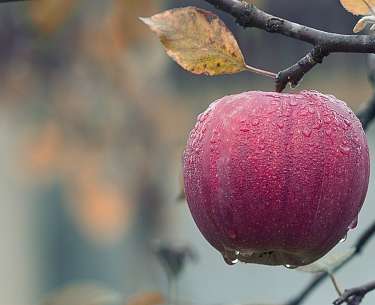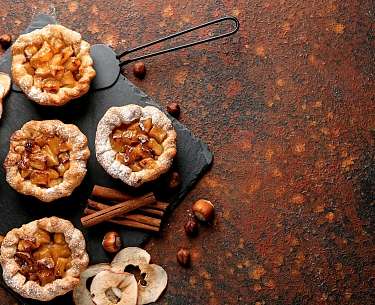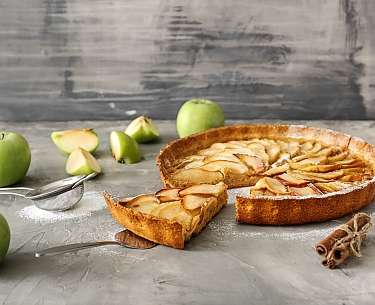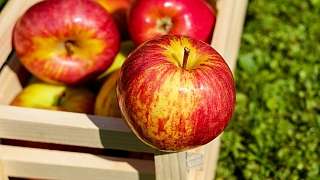Romantik Blog
Apples as a symbol
The temptation was great - and in the end Adam and Eve had to leave paradise because they had picked the forbidden fruit from the tree. At least that is how the Bible tells the story of the most famous of all apples. The couple were not entirely alone in their weakness for the fine fruit. For centuries, apples were considered a symbol of wealth, love and fertility, and, like the "orb", they were also considered a symbol of power. Even though apples are often described as a native fruit, they originally came from Central and Western Asia and then made their way to us via the Greeks and Romans.

With or without shell?
The skin of the apple is more than just its colourful cover. It contains numerous valuable ingredients, even more than the flesh. A high proportion of carotenoids strengthens the eyesight, protects the skin from UV radiation and keeps it fresh at the same time. In addition, most of the dietary fibres, antioxidants and the important vitamin C are found in the peel. So eating the skin is almost the most important part of enjoying the apple - as long as you rinse it thoroughly beforehand.

Good for the immune system
With a mix of eleven vitamins, twelve minerals and trace elements, the apple is a real powerhouse for health. Besides the vitamins that strengthen the immune system and protect against colds in winter, it contains plenty of flavonoids. According to studies, these secondary plant compounds can reduce the risk of bowel cancer. The intestine also benefits from the dietary fibres in apples, which regulate digestion and boost the metabolism. Another important phytochemical in apples, quercetin, has a preventive effect against bronchial asthma and improves general lung function.
Few calories, lots of water
An apple has just under 50 kilocalories and 85 percent water, making it ideal as a healthy snack that even helps to reduce weight. The dietary fibre pectin swells in the stomach, stimulates digestion and thus ensures a longer-lasting feeling of satiety.
Not in the fruit bowl
There are over 25,000 different apple varieties worldwide. What they have in common: They do not belong next to other fruits in the fruit bowl, because they emit the ripening gas ethylene. Therefore, no other fruit or vegetables should be stored near apples.

Sweet sins
Apples are not only a tasty source of vitamins when eaten raw, but also a popular ingredient in desserts. From apple strudel to baked apple, there are traditional specialities in every apple region.
Belgium: Famous for its exquisite waffles. Refined with apple juice or apple shavings, they become even juicier and acquire a fine autumnal aroma.
Germany: On cold autumn and winter evenings, a baked apple tastes particularly good. Filled with nuts, almonds, cinnamon and sugar, the delicious aroma alone is a delight.
Netherlands: The classic Dutch bake is the appeltaart. This covered apple pie is said to have been pleasing the palates of the Dutch since the Middle Ages.
Austria: Apple strudel is one of Austria's national dishes. Originally at home in the Arab world, it was brought over by the Turks.
Switzerland: Juicy apple rings coated in sweet pastry. Apple cakes with vanilla sauce are a Swiss speciality.

Dutch appeltaart
For the dough:
300 g flour, 1 egg
180 g cold butter
150 g brown sugar
Grate of 1 organic lemon
1 pinch of salt
For the filling:
4 large apples (Boskoop is best).
1 tbsp brown sugar, 1 tsp cinnamon
1 tbsp cornflour
100 g sultanas
Preparation:
Preheat the oven to 200 °C. Separate the egg, set the egg white aside. Mix flour and sugar, add butter in pieces and knead. Add the egg yolks, salt and lemon zest and knead until smooth. Shape the dough into a ball and leave to rest in the fridge for 45 minutes, wrapped in cling film. In the meantime, peel and core the apples and cut into cubes. Mix with cinnamon, sugar and cornflour, fold in sultanas. Line the greased springform pan with 3/4 of the rolled-out pastry, including the rim, and spread the apple and sultana mixture on top. Cut the rest of the pastry into strips and arrange them in a grid on top of the apple mixture. Brush the strips with egg white and bake at 200 °C for 60 minutes. Then leave to cool in the tin for 10 minutes.
Crunchy! The most important varieties
Boskoop
With its fruity, tart flavour, this winter apple from the Netherlands is particularly popular for all variations of apple pie. Ripe for picking: September/October. Ripe for eating: November to April.
Jonagold
This sweet and juicy variety is well suited for fresh consumption, but also for the production of juice and apple puree. Ripe for picking: September/October. Ripe for consumption: October to July.
Elstar
The most commonly cultivated variety in Germany is fruity-sweet with a slight acidity, tastes particularly good fresh, but is also popular for apple strudel. Ripe for picking: September/October. Ripe for eating: September to May.
Golden Delicious
This yellow-green apple with its fine spicy aroma is often used for breeding new varieties (e.g. Jonagold, Elstar) and also for making fruit brandy. Ripe for picking: September/October. Ripe for consumption: October to July.
Braeburn
This variety originates from New Zealand, but is also grown in Southern Europe. With its tart sweetness, Braeburn is ideal for compote or juice. Ripe for picking: October. Ripe for consumption: November to April.
Cox Orange
Cultivated in England since 1825, this sweet and sour variety is one of the most popular among the British and is also the breeding ancestor of other well-known varieties (e.g. Holsteiner Cox, Elstar, Gala). Ripe for picking: September. Ripe for eating: September to March.
Gala
Originally bred in New Zealand, Gala is a typical dessert apple: small and sweet, especially popular with children. Ripe for picking: September. Ripe for eating: September to December.
Post your comment
Comments
No one has commented on this page yet.
RSS feed for comments on this page RSS feed for all comments



